with photos by Lisa Baker-Richardson, Gary Richardson, Chris Manley, Dave Shute and Pete Eeles.
This report provides a summary of the butterflies observed on a trip made to south-west Switzerland from 9th to 15th July 2011. The members of the party were Chris Manley, Dave Shute, Gary Richardson, Lisa Baker-Richardson, Lynn Fomison, Peter Eeles and Tim Norriss. Our guide for the trip was none other than UK Butterflies team member (and a resident of Switzerland), Guy Padfield.
 |
| Back: Chris, Tim, Lynn, Guy. Front: Gary, Lisa, Dave, Pete Image © Gary Richardson |
The number of languages heard spoken on this trip really gives a sense of the countries surrounding Switzerland, with France to the west, Germany to the north, Austria to the east and Italy to the south. Oh yes, and there's Liechtenstein to the east as well!
 |
After a 7am flight from London, we arrived in Geneva at 9.30am (local time) and had soon collected our spacious 9-seater hire bus. With Tim at the wheel we drove east along the northern shore of Lake Geneva on what was a very warm sunny day, with the occasional Black Kite soaring overhead. After a pause at a service station to collect some food and drink we continued on around the eastern end of the lake before turning south, arriving at our chalet around 12.30pm.
This area of the country is blessed with a combination of deep valleys and mountains that are home to a plethora of fauna and flora. The most notable features are the Rhone river (and its tributaries) which flows to Lake Geneva to the west and beyond into France and, of course, the Swiss alps in the south of the country, running almost east-to-west. Our base was around 20 miles north of the characteristic "dog leg" that is the 90 degree change in direction of the Rhone as it switches from running north-east to south-west, to south-east to north-west, ultimately ending up in Lake Geneva, as shown in the map below.
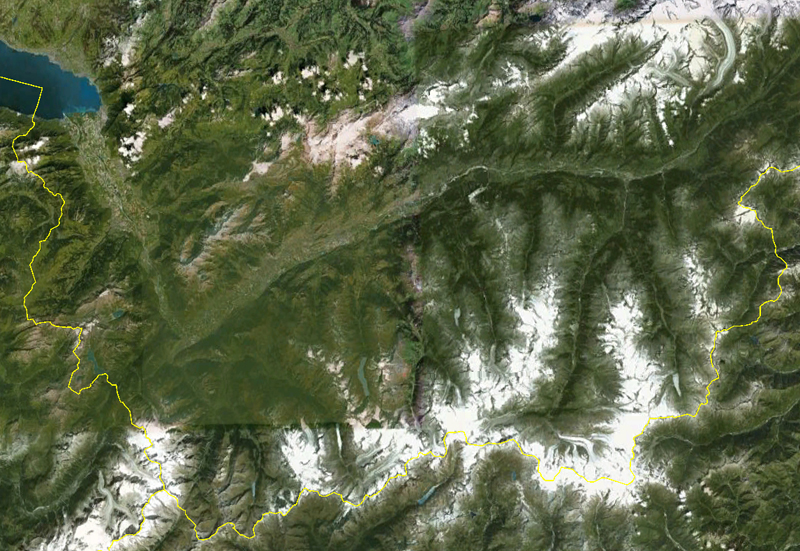 |
Switzerland is divided into a number of districts knows as cantons and we were to spend our time in south Vaud, south Bern (known as the Bernese Oberlands) and Valais. Due to the sensitive nature of the sites we visited, and the lack of protection afforded the wildlife in these areas, all sites in this report are described in terms of their canton, and distinguishing characteristics (such as "an alpine meadow").
 |
Having arrived at our chalet and unloaded our luggage, the first stop was the garden! Even here there were some surprises with a few Arran Brown (Erebia ligea) flying around and resting on nearby bushes when not nectaring. Half a dozen Lesser Marbled Fritillary (Brenthis ino) were also flying in the garden next door. Other species seen over the course of 30 minutes or so included Berger's Clouded Yellow (Colias alfacariensis), Dark Green Fritillary (Argynnis aglaja), Essex Skipper (Thymelicus lineola), Marbled White (Melanargia galathea), Meadow Brown (Maniola jurtina), Painted Lady (Vanessa cardui), Ringlet (Aphantopus hyperantus) and Small Tortoiseshell (Aglais urticae).
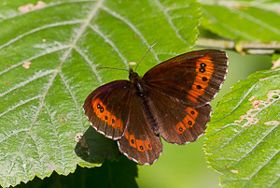 |  |  |
| Arran Brown (male) Image © Pete Eeles | Lesser Marbled Fritillary (male) Image © Pete Eeles | Lesser Marbled Fritillary Image © Lisa Baker-Richardson |
We still had some of the afternoon left to venture out and, based on some instructions from Guy (who we weren't to meet until the following day), we headed off to an alpine valley. The head of the valley was surrounded by impressive mountains and the valley meadows were dotted with fir trees and full of alpine flowers and butterflies. Despite the increasing wind and intermittent cloud we spent an absorbing few hours discovering its delights.
 |
| Monsieur Richardson Image © Lisa Baker-Richardson |
The first "wow" moment was finding a dozen or so male Damon Blue (Polyommatus damon) mud-puddling on a path at the base of the hill. Their undersides are reminiscent of the anomalous blues with a prominent white streak across the hindwing underside, together with uppersides that are simply stunning, giving off an electric sky blue that is difficult to capture in a photo.
 |  |  |
| Damon Blue (male) Image © Chris Manley | Damon Blue (male) Image © Pete Eeles | Damon Blue (male) Image © Pete Eeles |
A little further on we found some Cross Gentian (Gentiana cruciata) where we found quite a few eggs of the Alcon Blue (Phengaris alcon). We also managed to find a small number of female Alcon Blue in the area, which had clearly seen better days. Still, it was great to see this very scarce butterfly doing so well. Tim also managed to find several Small Blue (Cupido minimus) ova on Kidney Vetch.
 |  |
| Alcon Blue ova Image © Pete Eeles | Alcon Blue (female) Image © Pete Eeles |
 |  |
| Small Blue ovum Image © Pete Eeles | Small Blue ovum Image © Pete Eeles |
The hillside revealed a few other gems including several Scotch Argus (Erebia aethiops) and a very fresh and beautiful Large Wall Brown (Lasiommata maera). A little further on we also found several Carline Skipper (Pyrgus carlinae) taking up minerals from the water around a trough in the last few rays of sun before the clouds moved over. Other species seen on the hillside included Berger's Clouded Yellow (Colias alfacariensis), Black-veined White (Aporia crataegi), Brown Argus (Aricia agestis), Chalkhill Blue (Polyommatus coridon), Common Blue (Polyommatus icarus), Dark Green Fritillary (Argynnis aglaja), Dingy Skipper (Erynnis tages), Eros Blue (Polyommatus eros), Essex Skipper (Thymelicus lineola), Heath Fritillary (Melitaea athalia), Large Grizzled Skipper (Pyrgus alveus), Mazarine Blue (Cyaniris semiargus), Painted Lady (Vanessa cardui), Small Blue (Cupido minimus), Small Tortoiseshell (Aglais urticae) and Swallowtail (Papilio machaon). Day-flying moths included Shaded Broad-bar, Chimney Sweeper, Bright Wave and Grass Rivulet.
 |  |  |
| Scotch Argus Image © Pete Eeles | Large Wall Brown Image © Pete Eeles | Carline Skipper Image © Pete Eeles |
In the firs Tim and Dave found a roving flock of tits and managed to pick out Coal, Crested and Willow Tit as well as Crossbill. They were soon trumped by Gary who picked up a large raptor flying along a cliff face. It turned out to be a Lammergeier and they watched it glide and then flap slowly across the valley before appearing to land in a cleft in the rocks. In terms of flora, the meadows were dominated by the tall 3-foot spires of Great Yellow Gentian but other flowers to catch the eye were Wood Crane's-bill, Cypress Spurge, Great Masterwort, Yellow Woundwort, Alpine Bistort and the aforementioned Cross Gentian.
Despite our early start and day of travelling, Tim and Chris were keen to put out their moth traps before going to bed.
A - Vaud (on way to chalet)
B - Chalet at Barboleuse
C - South-east Vaud
(Items in green represent the first sighting for the trip for a given species)
 |
Today was the first time we'd awoken in the chalet and everyone who walked into the lounge, without exception, was taken aback by the superb views of the snow-capped mountains in the distance.
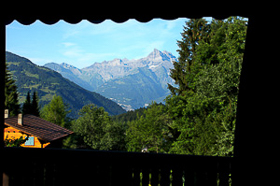 |  |
| View from the Chalet Image © Gary Richardson | View from the Chalet Image © Pete Eeles |
Most of us awoke around 7am, only to find Tim and Chris already well-advanced in processing the moth catch and there was a good number of moths resting on the walls of the chalet. Highlights were Blomer's Rivulet, Large Emerald, Olive Crescent, Pale Shining Brown, Pine Tree Lappet, Purple Treble-bar, Small Yellow Wave and the green form of Barred Red.
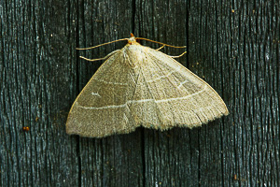 |  |  |
| Olive Crescent Image © Chris Manley | Pale Shining Brown Image © Chris Manley | Pine Tree Lappet Image © Chris Manley |
The first order of the day was to collect our guide (!) who we met at the local railway station. We then set off to an area in south-East Vaud where a sphagnum bog played host to a colony of Cranberry Fritillary (Boloria aquilonaris), a species that none of the group had seen before. Most were past their best, but it was nonetheless delightful watching these little fritillaries bobbing around between Cranberry plants. The site also revealed several False Heath Fritillary (Melitaea diamina) and Titania's Fritillary (Boloria titania) as well as a few Black-veined White (Aporia crataegi), Lesser Marbled Fritillary (Brenthis ino), Lesser Mountain Ringlet (Erebia melampus) and Small Heath (Coenonympha pamphilus).
 |  |
| Cranberry Fritillary (male) Image © Pete Eeles | Cranberry Fritillary (female) Image © Pete Eeles |
 |  |  |
| False Heath Fritillary Image © Pete Eeles | Titania's Fritillary (male) Image © Pete Eeles | Titania's Fritillary (female) Image © Pete Eeles |
We then moved on to south Bern - the Bernese Oberland. The site we visited was at 1400m and, with equipment readied, we made our way by the side of a stream where Chris managed to catch a glimpse of a Chequered Skipper (Carterocephalus palaemon) before we moved into a wetland area where we had our first sightings of Niobe Fritillary (Argynnis niobe) which were out in very good numbers and one individual appearing relatively-dark. Our walk was accompanied by the pleasant, if slightly mournful sound of an Alpenhorn quartet.
 |  |
| Chequered Skipper Image © Chris Manley | Alpenhorn Quartet Image © Pete Eeles |
 |  |  |
| Niobe Fritillary Image © Pete Eeles | Niobe Fritillary Image © Pete Eeles | Guy the Guide! Image © Pete Eeles |
Further on we tracked down 2 specialties for this site - Dusky Large Blue (Phengaris nausithous) and Scarce Large Blue (Phengaris teleius) - both extremely rare species of butterfly, and both related to our own Large Blue. The Dusky Large Blue were, without exception, either resting, nectaring or ovipositing on Great Burnet (Sanguisorba officinalis). They were uniform brown below with a single row of black dots and the uppersides, when rarely glimpsed, were almost devoid of blue colouring. The Scarce Large Blue were almost exclusively females, and some very fresh indeed. A few females were also ovipositing on Great Burnet. As for our own Large Blue, both species feed on the foodplant in early instars before dropping to the ground in the hope of being found by ants which then take them back to their nests where their new guest devours their grubs.
 |  |  |
| Dusky Large Blue Image © Dave Shute | Dusky Large Blue ovipositing Image © Pete Eeles | Pete and Guy Image © Lisa Baker-Richardson |
 | 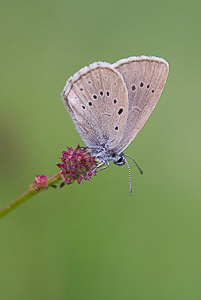 | 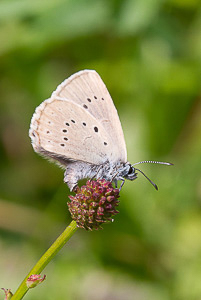 |
| Scarce Large Blue (female) Image © Pete Eeles | Scarce Large Blue (female) Image © Pete Eeles | Scarce Large Blue ovipositing Image © Pete Eeles |
Other butterfly species seen at this incredible site were Alpine Heath (Coenonympha gardetta), Arran Brown (Erebia ligea), Black-veined White (Aporia crataegi), Chalkhill Blue (Polyommatus coridon), Dark Green Fritillary (Argynnis aglaja), False Heath Fritillary (Melitaea diamina), Large Ringlet (Erebia euryale), Large Skipper (Ochlodes sylvanus), Lesser Marbled Fritillary (Brenthis ino), Mazarine Blue (Cyaniris semiargus), Purple-edged Copper (Lycaena hippothoe), Ringlet (Aphantopus hyperantus), Small Blue (Cupido minimus), Small Skipper (Thymelicus sylvestris), Small White (Pieris rapae), Swallowtail (Papilio machaon), Titania's Fritillary (Boloria titania) and Yellow-spotted Ringlet (Erebia manto).
 | 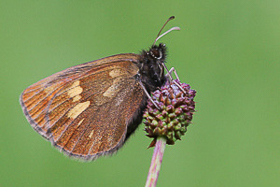 |
| Yellow-Spotted Ringlet Image © Pete Eeles | Yellow-Spotted Ringlet Image © Lisa Baker-Richardson |
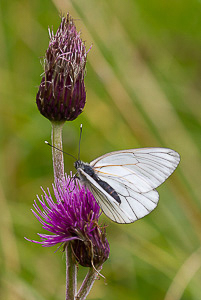 |  |
| Black-Veined White Image © Pete Eeles | Large Ringlet Image © Pete Eeles |
Some of the more interesting plants included Monkshood, White False Helleborine, Grass-of-Parnassus, Marsh Felwort, Betony-leaved Rampion, Lesser Butterfly and Burnt-tip Orchids and Bearded Bellflower. As we progressed we came to damper ground that had Marsh Helleborines, Marsh Fragrant Orchids, Marsh Lousewort and Cabbage and Melancholy Thistles. A longhorn beetle, Leptura virens (with a greenish bloom to its elytra), was found feeding on the white umbel flowers of Wild Angelica. Where the path entered woodland we saw the tall pallid-flowering spikes of the poisonous Wolfsbane and in the grassy clearings Common Cow-wheat and the diminutive Alpine Bastard-Toadflax. The attractive Bee Beetle (Trichius sp.) was found nectaring on Great Masterwort - the hairy thorax and yellow and black barred elytra mimicking a bumble-bee. Scores of young frogs were crossing the path in places and examination of the flower-heads of umbellifer plants produced the striking soldier fly Stratiomys chameleon with a flattened, yellow and black striped abdomen.
 |  |
| Marsh Felwort Image © Dave Shute | Bee Beetle Image © Dave Shute |
After completing our walk around the site, it started to rain and so we adjourned to a local bar for a beer and ended up staying for supper!
D - South-east Vaud
E - South Bern (Bernese Oberland)
 |
The moth traps had been activated overnight and the catch included Black V Moth, Clay Triple-lines, Gold Spangle, Maple Prominent, Pale Shining Brown, Pine Carpet, Rannoch Looper, Silvery Arches and Small Rivulet.
 |  |  |
| Gold Spangle Image © Chris Manley | Maple Prominent Image © Chris Manley | Rannoch Looper Image © Chris Manley |
Today we ventured further afield, traveling past the "dog leg" of the Rhone toward some seriously tall and snow-capped mountains, in order to explore some alpine habitats. The first stop of the day, however, was in central Valais on the valley floor, alongside one of the tributaries of the Rhone. The first butterfly seen as we got out of the van was an Eastern Bath White (Pontia edusa), quickly followed by a multitude of Great Sooty Satyr (Satyrus ferula).
 | 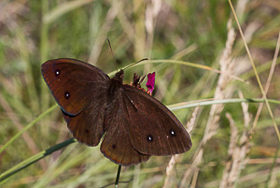 |  |
| Eastern Bath White Image © Gary Richardson | Great Sooty Satyr Image © Pete Eeles | Great Sooty Satyr Image © Pete Eeles |
One of the most spectacular butterflies seen was Apollo (Parnassius apollo) which seemed to float effortlessly along for a butterfly of its size. We were also lucky to catch up with a pristine Provental Fritillary (Melitaea deione) as well as a pristine Knapweed Fritillary (Melitaea phoebe). A few familiar companions from previous European trips were also with us, including Queen of Spain Fritillary (Issoria lathonia) and Scarce Swallowtail (Iphiclides podalirius).
 |  |
| Apollo Image © Chris Manley | Apollo Image © Chris Manley |
 |  |
| Provental Fritillary Image © Gary Richardson | Knapweed Fritillary Image © Lisa Baker-Richardson |
 |  |
| Queen of Spain Fritillary Image © Gary Richardson | Scarce Swallowtail Image © Pete Eeles |
Another specialty for this site was a good number of Provental Short-tailed Blue (Cupido alcetas). A single Mallow Skipper (Carcharodus alceae) was also seen, along with several Rock Grayling (Hipparchia hermione), just as we were leaving the site.
 |  |  |
| Provental Short-tailed Blue Image © Pete Eeles | Mallow Skipper Image © Lisa Baker-Richardson | Rock Grayling Image © Pete Eeles |
Other species seen at this site included Berger's Clouded Yellow (Colias alfacariensis), Black-veined White (Aporia crataegi), Brimstone (Gonepteryx rhamni), Brown Argus (Aricia agestis), Chalkhill Blue (Polyommatus coridon), Common Blue (Polyommatus icarus), Dark Green Fritillary (Argynnis aglaja), Dusky Meadow Brown (Hyponephele lycaon), Heath Fritillary (Melitaea athalia), Holly Blue (Celastrina argiolus), Ilex Hairstreak (Satyrium ilicis), Marbled White (Melanargia galathea), Meleager's Blue (Polyommatus daphnis), Painted Lady (Vanessa cardui), Red Admiral (Vanessa atalanta), Red-underwing Skipper (Spialia sertorius), Silver-washed Fritillary (Argynnis paphia), Small Heath (Coenonympha pamphilus), Small White (Pieris rapae), Southern Small White (Pieris mannii), Southern White Admiral (Limenitis reducta), Spotted Fritillary (Melitaea didyma), Swallowtail (Papilio machaon) and Wood White (Leptidea sinapis).
The Nine-spotted (Syntomis phegea), an attractive day-flying moth, was nice to see and several Hummingbird Hawkmoths were attracted to Viper's Bugloss blooms. The flat-topped umbellifer flowers again proved irresistible to a variety of insects including the shocking crimson and black shieldbug Eurydema ornatum, the beautiful yellowish-green longhorn beetle Chlorophorus varius and the red and black beetle Trichodes apiarius whose larvae feed on the grubs of solitary bees. Amongst the array of plants we discovered Nottingham and Sticky Catchflies and the arresting Carthusian Pink. Just as we were about to depart a large Violet Carpenter Bee put in a brief appearance.
 |
| Eurydema ornatum and Chlorophorus varius Image © Dave Shute |
We then headed up toward an alpine pass but stopped off at another site simply because of the number of butterflies we could see out of the van! This particular area was next to a path that led down to the river, which we followed. It's amazing how simply stopping in an unexplored area can throw up a few surprises. Of the species found, the ringlets were showing very well with sightings of Almond-eyed Ringlet (Erebia alberganus), Lesser Mountain Ringlet (Erebia melampus), Marbled Ringlet (Erebia montana) and Swiss Brassy Ringlet (Erebia tyndarus). We also had first sightings for the trip of Glandon Blue (Plebejus glandon), Idas Blue (Plebejus idas), Large Blue (Phengaris arion) and Scarce Copper (Lycaena virgaureae).Other species included Apollo (Parnassius apollo), Berger's Clouded Yellow (Colias alfacariensis), Clouded Yellow (Colias crocea), Dark Green Fritillary (Argynnis aglaja) and Small Tortoiseshell (Aglais urticae).
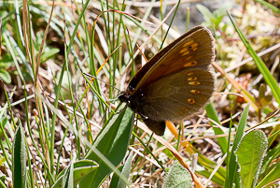 |  |
| Almond-eyed Ringlet Image © Pete Eeles | Almond-eyed Ringlet Image © Pete Eeles |
 |  |
| Swiss Brassy Ringlet Image © Dave Shute | Swiss Brassy Ringlet Image © Pete Eeles |
We finally made our way up to the alpine pass to around 2000m where we parked the van before continuing on foot. Although rocky underfoot, the area was filled with alpine flowers that provided a dazzling display and we'd come across Chamois every now and again and also the occasional Marmot. It was difficult not to break into "Edelweiss" from The Sound of Music when seeing this species, in flower, first-hand! One slope was awash with scores of this white-woolly member of the daisy family. Other notable plants were Alpine Toadflax, Black Vanilla Orchid, Snow and Spring Gentians, Globeflower, Frog Orchid, Wood and Carthusian Pinks, Moss Campion, Yellow Alpine Pasqueflower, Mountain Avens, Roseroot, Cobweb Houseleek, Yellow Mountain Saxifrage, Round-headed Rampion, Yellow Oxytropis, Birds-eye Primrose, Rock Speedwell, Alpine Bartsia and Alpine Aster.
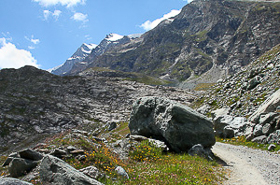 |  |  |
| The Path Ahead Image © Gary Richardson | Alpine Flowers Image © Chris Manley | Chamois Image © Pete Eeles |
 | 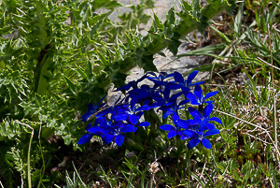 |  |
| Edelweiss Image © Pete Eeles | Spring Gentian Image © Pete Eeles | Spring Gentian Image © Chris Manley |
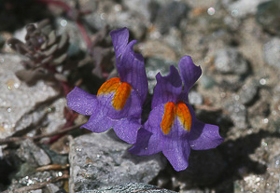 |  |  |
| Alpine Toadflax Image © Dave Shute | Mountain Avens Image © Dave Shute | Black Vanilla Orchid Image © Dave Shute |
One of the first butterflies seen was a Mnestra's Ringlet (Erebia mnestra), with characteristic extensive blotches of red on the wings. At the base of a long climb up were many other specialties, including Alpine Blue (Plebejus orbitulus) and Alpine Heath (Coenonympha gardetta). Grisons Fritillary (Melitaea varia), Idas Blue (Plebejus idas), Mountain Fritillary (Boloria napaea) and Shepherd's Fritillary (Boloria pales) were all nectaring on the floral feast that the flower-filled alpine hillsides offered up. A small number of beautiful male Purple-edged Copper (Lycaena hippothoe) were also seen.
 | 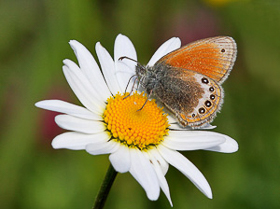 |  |
| Mnestra's Ringlet Image © Pete Eeles | Alpine Heath Image © Gary Richardson | Grisons Fritillary Image © Pete Eeles |
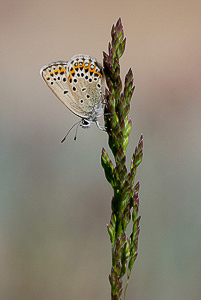 |  |  |
| Idas Blue Image © Pete Eeles | Idas Blue Image © Pete Eeles | Idas Blue Image © Lisa Baker-Richardson |
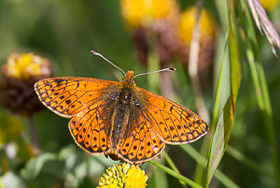 | 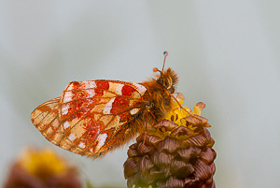 | 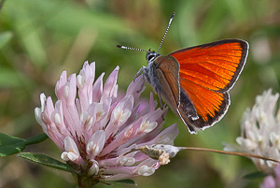 |
| Mountain Fritillary Image © Pete Eeles | Mountain Fritillary Image © Pete Eeles | Purple-Edged Copper Image © Pete Eeles |
Further up the mountainside we were treated to yet more specialist species, the highlights of which were Cynthia's Fritillary (Euphydryas cynthia), Mountain Clouded Yellow (Colias phicomone), Mountain Ringlet (Erebia epiphron), Peak White (Pontia callidice) and, to round off a perfect day of butterflying, Small Apollo (Parnassius phoebus). Dewy Ringlet (Erebia pandrose), Dusky Grizzled Skipper (Pyrgus cacaliae), Long-tailed Blue (Lampides boeticus) and Small Blue (Cupido minimus) were also seen.
 |  |
| Cynthia's Fritillary Image © Pete Eeles | Cynthia's Fritillary Image © Pete Eeles |
 |  | 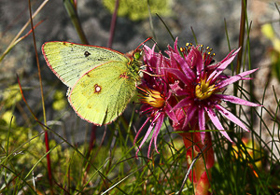 |
| Mountain Clouded Yellow Image © Pete Eeles | Mountain Clouded Yellow Image © Pete Eeles | Mountain Clouded Yellow Image © Chris Manley |
 |  |
| Mountain Ringlet Image © Pete Eeles | Mountain Ringlet Image © Pete Eeles |
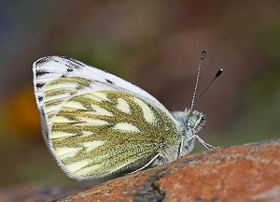 |  |
| Peak White Image © Gary Richardson | Small Apollo Image © Gary Richardson |
The burnet moth Zygaena exulans was abundant and often covered the track-side flowers and the pale orange-yellow Dew Moth occurred in two forms, the familiar black-spotted and one with black stripes. It was found alongside the closely-related Setina ramosa. Another common yellow moth proved frustratingly elusive but was eventually identified as Crocota tinctaria. Tim and Dave managed to photograph the Alpine Tiger Beetle (Cicindela gallica). Water Pipit, Black Redstart and distant Alpine Chough were the only birds noted.
 |  |  |
| Zygaena exulans Image © Chris Manley | Dew Moth Image © Dave Shute | Setina ramosa Image © Chris Manley |
Once off the mountain we arranged to meet Paul Wetton and his partner, Helen, at a local bar. Paul and Helen had driven over to Switzerland from the UK in order for Paul to get video footage for his DVD Searching for Butterflies in South West Switzerland and we shared stories of where we'd been and what we'd seen along the way. While Paul and Helen were with us, it seemed the perfect time for Guy to receive the UK Butterflies Outstanding Contribution Award for 2011 from the 2010 winners, Gary and Lisa - receiving a copy of Ecology of Butterflies in Europe. It was now getting late and so we decided to stay here for supper and found a very good Chinese restaurant.
 |
| 2010 and 2011 UKB Outstanding Contribution Award Winners! Image © Pete Eeles |
F - Central Valais (valley floor)
G - Valais upland
H - Valais alpine pass
 |
Having had a long day in the mountains the previous day, the temptation was to spend the day in the local area. However, the weather forecast for the following couple of days wasn't looking promising and we knew we had to make the most of the good weather. And so we decided to make another lengthy trip to another alpine pass in Valais. Picking Guy up on the way, we headed directly to our destination without stopping. We were also joined by Paul and Helen and spent some time climbing up the mountain path to some high grassy meadows.
 |  |
| Alpine Pass Image © Gary Richardson | Paul in Action! Image © Pete Eeles |
At the lower elevations we encountered a lot of boggy grassland which was home to a large population of the Wart-Biter Cricket (a British rarity) and a couple of huge frogs. The boggy ground also produced the large grasshopper Arcyptera fusca (similar to the British Large Marsh Grasshopper but with a different stridulation). Bog-loving plants included Wood Crane's-bill, Southern Butterwort, Tofield's Asphodel and Bistort. Alongside the track Dave also recorded Alpenrose, Field Gentian, Stellar Hare's-ear, Purple Gentian, Hoary Groundsel and Mountain Everlasting.
It wasn't long before we came across a new butterfly species for the trip, the first being Cranberry Blue (Plebejus optilete) with its characteristic red and blue eyespot on the hindwing, as well as a single tatty Geranium Argus (Aricia eumedon) that was found on Wood Crane's-bill. Despite the mountain breeze, we were able to get good views of some butterfly species we'd already encountered on the trip, not least the alpine form of Purple-edged Copper (Lycaena hippothoe) - f. eurydame. A little further on we came across a muddy puddle with several blues flying around. Here we managed to get good views of a male Glandon Blue (Plebejus glandon).
 | 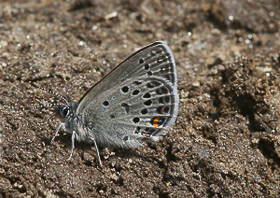 |
| Cranberry Blue Image © Pete Eeles | Cranberry Blue Image © Dave Shute |
 |  |  |
| Purple-Edged Copper (male) Image © Pete Eeles | Purple-Edged Copper (male) Image © Pete Eeles | Purple-Edged Copper (female) Image © Chris Manley |
 |  |  |
| Watching the Blues Image © Chris Manley | Glandon Blue (male) Image © Pete Eeles | Glandon Blue (male) Image © Pete Eeles |
Further on still we came across a mating pair of Marsh Fritillary (Euphydryas aurinia) of the form f. debilis. We also came across a female Mazarine Blue ovipositing on Clover and managed to get some shots of the resulting egg. We also came across a very colourful female Mountain Fritillary (Boloria napaea) with a characteristic bronze sheen across the wings.
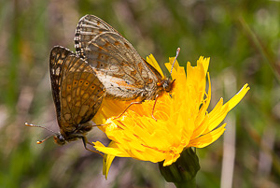 |  |  |
| Marsh Fritillary Image © Pete Eeles | Mazarine Blue (egg) Image © Pete Eeles | Mazarine Blue (egg) Image © Pete Eeles |
 |  |
| Mountain Fritillary (female) Image © Chris Manley | Mountain Fritillary (female) Image © Chris Manley |
We eventually reached a plateau where it was a challenge to find shelter from the wind. Even so, there were still good numbers of butterflies around, including quite a few Niobe Fritillary (Argynnis niobe). Mountain Clouded Yellow (Colias phicomone) were out in good numbers and courting couples provided the opportunity to see their somewhat "smokey" uppersides. A single Marbled Ringlet (Erebia montana) was also found here, along with Small Apollo (Parnassius phoebus).
 |  |
| Niobe Fritillary (male) Image © Pete Eeles | Niobe Fritillary (male) Image © Pete Eeles |
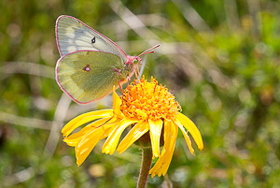 |  |  |
| Mountain Clouded Yellow Image © Pete Eeles | Mountain Clouded Yellow (male) Image © Pete Eeles | Mountain Clouded Yellow (female) Image © Pete Eeles |
 | 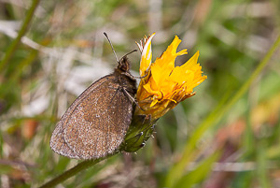 |
| Marbled Ringlet Image © Pete Eeles | Marbled Ringlet Image © Pete Eeles |
 | 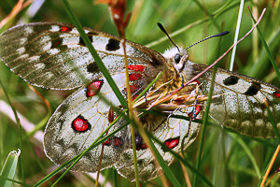 |
| Small Apollo (female) Image © Chris Manley | Small Apollo (female) Image © Chris Manley |
Other species seen included Alpine Heath (Coenonympha gardetta), Dark Green Fritillary (Argynnis aglaja), Dusky Grizzled Skipper (Pyrgus cacaliae), Green Hairstreak (Callophrys rubi), Idas Blue (Plebejus idas), Large Blue (Phengaris arion), Large Grizzled Skipper (Pyrgus alveus), Mazarine Blue (Cyaniris semiargus), Mnestra's Ringlet (Erebia mnestra), Moorland Clouded Yellow (Colias palaeno), Northern Brown Argus (Aricia artaxerxes), Silver-spotted Skipper (Hesperia comma), Small Blue (Cupido minimus) and Small Skipper (Thymelicus sylvestris). It was certainly strange seeing Silver-spotted Skipper (Hesperia comma) in such unfamiliar surroundings; this wasn't exactly chalk downland!
I - Valais alpine pass
 |
As predicted we woke to a heavy downpour. Fortunately, the moth traps were set up under the verandah and as there was little prospect of venturing out we had more time than usual to examine the catch. Some moths of interest were a female Archips oporana, Antler Moth, Beautiful Hook-tip, Brown-line Bright-eye, Common Lutestring, Green Arches, Purple-bar, Rosy Footman, Scallop Shell, Scarce Footman, Small Angle Shades, Square-spotted Clay, Swallow-tailed Moth, Scarce Blackneck and Small White Wave. A snake-fly (Raphidia sp.) and a giant lacewing were interesting by-catches.
 |  | 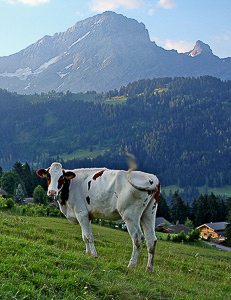 |
| Archips oporana Image © Chris Manley | Snake-fly Image © Dave Shute | A Typical Swiss Scene! Image © Gary Richardson |
The rain persisted for the entire day and gave us the opportunity to examine the photos already taken, apart from a brief excursion to the supermarket to prepare for Lynn's roast chicken dinner; a well-received culinary delight!
It was colder this morning with a low mist shrouding the mountains. We couldn't bear the thought of another day indoors so we planned to go to the top of a nearby mountain to see if we could climb above the cloud.
We took the tram to Villars where we boarded a cable-car to the mountain top at Roc d'Orsay. Our optimism was misplaced as it was even colder up there and very limited visibility! Despite the conditions, Dave found Spiked Rampion and Alpine Buttercup. We followed the well-marked gravel path down to the railway station at Bretaye where we met up with Guy but the weather showed no sign of clearing. We walked back up to the cable-car and then we split-up into two groups, one opting for a hike uphill whilst others headed back down to Villars. The second group saw a small flock of Crossbills and Tim found a poor bedraggled Chalkhill Blue on a grass stem, the only butterfly for two days! The first group decamped to a local bar and spent most of the afternoon drinking the local beer while watching the Tour de France and discussing the meaning of life, the universe, and everything.
Our last day was, thankfully, blessed with good weather and we decided to visit a few relatively-local sites. The first site was a chalky hillside off the main road that runs alongside the Rhone. An Eastern Bath White (Pontia edusa) was nectaring next to our parking area and a little further up the road there were good numbers of Southern Small White (Pieris mannii).
 |
| A View of the Rhone Image © Pete Eeles |
 |  |
| Southern Small White (male) Image © Pete Eeles | Southern Small White Image © Pete Eeles |
Numerous grasshoppers "flew" up in front of us as these were Red Underwing and Blue Underwing grasshoppers with extensive membranous underwings which allow them to glide away from danger. Where the track entered woodland there were numerous brown moths which seemed to never settle. Their identity was confirmed as Gypsy Moths by Guy. Sickle-leaved Hare's-ear, Spiked Speedwell and Mountain Germander were new plants for us. Quite a few Silver-washed Fritillary (Argynnis paphia) were also flying, including a female of the form valesina.
 |  |
| Silver-Washed Fritillary (f.valesina) Image © Chris Manley | Silver-Washed Fritillary (f.valesina) Image © Chris Manley |
When we reached the rocky summit we had Crag Martins flying around us and the grassy summit was covered in "sedums" (Common Houseleeks and stonecrops). Here we found two new burnet moths; Zygaena osterodensis with red bands rather than spots and Zygaena carniolica with white borders to its red spots. Despite the breeze, there were several sheltered areas where most of the butterflies were to be found, including good numbers of Great Sooty Satyr (Satyrus ferula), Spotted Fritillary (Melitaea didyma) and Wall Brown (Lasiommata megera). We also found a Spotted Fritillary larva and managed to get a shot of larva and adult together. A Hummingbird Hawkmoth egg was also found on bedstraw.
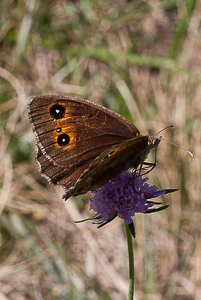 |  |  |
| Great Sooty Satyr (male) Image © Pete Eeles | Great Sooty Satyr Image © Pete Eeles | Great Sooty Satyr (mating pair) Image © Pete Eeles |
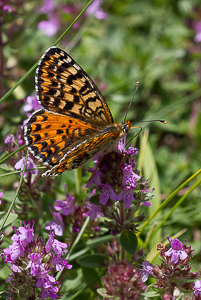 |  |  |
| Spotted Fritillary (female) Image © Pete Eeles | Spotted Fritillary (larva) Image © Lisa Baker-Richardson | Spotted Fritillary (male and larva) Image © Pete Eeles |
 |
| Wall (caught by a Crab Spider) Image © Pete Eeles |
Other species seen included Adonis Blue (Polyommatus bellargus), Amanda's Blue (Polyommatus amandus), Berger's Clouded Yellow (Colias alfacariensis), Black-veined White (Aporia crataegi), Chalkhill Blue (Polyommatus coridon), Clouded Yellow (Colias crocea), Common Blue (Polyommatus icarus), Dingy Skipper (Erynnis tages), Dryad (Minois dryas), Green-veined White (Pieris napi), Grizzled Skipper (Pyrgus malvae), Heath Fritillary (Melitaea athalia), Holly Blue (Celastrina argiolus), Large Skipper (Ochlodes sylvanus), Mallow Skipper (Carcharodus alceae), Marbled White (Melanargia galathea), Northern Brown Argus (Aricia artaxerxes), Purple Hairstreak (Favonius quercus), Queen of Spain Fritillary (Issoria lathonia), Scarce Swallowtail (Iphiclides podalirius), Scotch Argus (Erebia aethiops), Small White (Pieris rapae) and Speckled Wood (Pararge aegeria).
We then moved on to another site on the valley floor with a particular target species in mind - Meleager's Blue (Polyommatus daphnis). On our way up a Lesser Stag Beetle was rescued from the road and a small grassy meadow was attracting a few blues, a Jersey Tiger moth and a Violet Carpenter Bee. Alongside a path we found good amounts of Crown Vetch (Coronilla varia), the larval foodplant of Meleager's Blue. It wasn't long before we found our first adults with the characteristic scalloped edges to the hindwings, including the very beautiful dark brown steeveni form of the female.
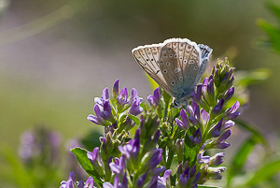 |  |
| Meleager's Blue (male) Image © Pete Eeles | Meleager's Blue (female) Image © Pete Eeles |
Other species seen at this site include Adonis Blue (Polyommatus bellargus), Apollo (Parnassius apollo), Berger's Clouded Yellow (Colias alfacariensis), Chalkhill Blue (Polyommatus coridon), Chapman's Blue (Polyommatus thersites), Clouded Yellow (Colias crocea), Common Blue (Polyommatus icarus), Holly Blue (Celastrina argiolus), Large Skipper (Ochlodes sylvanus), Large White (Pieris brassicae), Marbled White (Melanargia galathea), Red Admiral (Vanessa atalanta), Scarce Swallowtail (Iphiclides podalirius) and the seemingly-ubiquitous Spotted Fritillary (Melitaea didyma).
A pretty little brown micro moth with four yellow spots (Dysauxes punctata) was also seen. Quite a few Hummingbird Hawkmoths were also coming to Viper's Bugloss.
As we headed back to the chalet, our last stop of the day was in some woodland in South-east Vaud. We were lucky enough to notch up 4 new species for the trip - Comma (Polygonia c-album), White Admiral (Limenitis camilla), White-letter Hairstreak (Satyrium w-album) and Woodland Brown (Lopinga achine), of which we had a fleeting glimpse. We also had sightings of Arran Brown (Erebia ligea), Large Skipper (Ochlodes sylvanus), Meadow Brown (Maniola jurtina), Provental Short-tailed Blue (Cupido alcetas), Ringlet (Aphantopus hyperantus), Silver-washed Fritillary (Argynnis paphia), Small Skipper (Thymelicus sylvestris), Speckled Wood (Pararge aegeria) and a very photogenic Wood White (Leptidea sinapis).
 |
| Wood White (male) Image © Gary Richardson |
Villars was the choice for our last night supper with a sumptuous self-service salad bar. Plates were piled high, too high in some cases, as eyes became bigger than stomachs! We then said our farewells to Guy before returning to the chalet. Here we reflected on seeing 108 butterflies, as well as many other species, in what was, effectively, 5 days of butterflying. Quite incredible!
J - Western Valais (valley floor)
K - Western Valais (valley floor)
L - South-east Vaud
 |
All of those on the trip would like to thank Guy for his guidance, generosity and patience. Guy is one of a handful of European butterfly experts and anyone reading this article should visit his excellent website at www.guypadfield.com.
 |